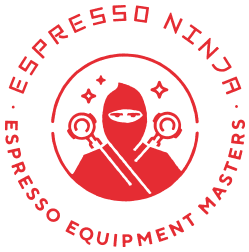Your grinder is your most important tool in making coffee- this is where you control how your shots run- and how your coffee tastes!
Be prepared to waste a little coffee when you’re setting your grind for the first time- even experienced baristas have trouble setting the perfect grind, it does take some trial and error.
Is your extraction too slow? Too fast? Not coming out at all? This more than likely indicates that the grinder setting needs to be adjusted. The espresso machine itself should have its temperature, flow rate and pressure all calibrated already, unless there is a fault with the machine. It’s always best to try the grinder first. Most cafés would need to change the grind setting several times a day depending on the temperature, humidity etc.
For espresso, there are recognised industry average standards for shot time and volume. Most try to get a single espresso to pour 30ml including crema in around 25 seconds. For a double espresso, it’s 60ml including crema in around 25 seconds. If you can get your extractions close to this, that is a great starting point. It’s important to note however that you can play with these parameters to suit yourself. Coffee is subjective of course, so it’s all up to you.
Most grinders will have a labelled collar, or grind adjustment. This should state which way to adjust the grind to get it finer or coarser. The finer you set the grind, the slower the extraction will be. The coarser you set the grind, the faster the extraction will be.
The same applies to the amount of coffee grounds in your portafilter. If you leave the grind setting where it is, but put more coffee grounds into the portafilter, the extraction will slow.
A couple of grams will make all the difference. Keep trying until you get it right.
Distribution and tamping
The way that you distribute coffee grounds into the portafilter basket and tamp the coffee is important. Water is lazy, so if there is an easy path through the grounds, that’s where the water will go. The aim is to have a level and consistent distribution of coffee grounds in the basket so that the water flows around every coffee particle evenly- from top to bottom. Try to get your tamp perfectly level and tamp with consistent pressure each time.
One good way to investigate is by looking at the coffee grounds (or puck) after your extraction. If there are small holes in the puck, that indicates channelling of the water through the coffee. The puck should also be relatively solid and dry. If the puck is wet and sloppy it can indicate an incorrect grind setting, incorrect distribution/tamping or even that the coffee is too old to produce a quality espresso.
As always, fresh is best. Roasted coffee beans are (generally speaking) really only at their best for up to 2-3 weeks after being roasted. We always recommend buying local!

